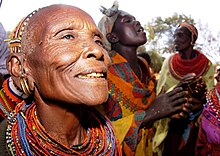Borana
The Borana (also written Borena or - in accordance with the fact that the last vowel of the word is mute - Boran ) are a subgroup of the Oromo people. Their total number is estimated at about 4 million, most of which are in the south of Ethiopia , about 150,000 to 175,000 in the Eastern Region of Kenya and a few in the region Gedo in Somalia live.
Language of the Borana is the Borana, which belongs to the southern dialects of the Oromo language and is also spoken by the Gabbra and Sakuye. They are traditionally cattle breeders, although today some also keep sheep, goats or even camels or do arable farming. Their traditional religion is monotheistic with a god Waka ; Islam has grown in influence among them over the past 70 years, and a few Borana are Christians.
From 2009 to 2017, cattle farmer Guyyoo Gobbaa was elected King of the Borana. In 2017 he was replaced by Kura Jarso following the traditions of the Oromo. People's problems include conflicts with neighboring ethnic groups and cattle theft. and drought , which is expected to intensify in their region due to climate change .
history
After Bahrey , the Borana were the second subgroup of the Oromo next to the Baraytuma (also: Barentuma ) in the 16th century . From their area of origin in the southern Ethiopian highlands, the Baraytuma moved north and east into large parts of what is now Ethiopia. The Borana, however, penetrated in a southerly direction into large areas of northern Kenya and into the area west of the Juba ( Jubaland ) in what is now Somalia. In doing so, they displaced somaloid groups living there in front of them . The gada age class system is said to have played a key role: every eight years a new generation of young Borana men had to move out and bring the severed genitals of an enemy as a trophy in order to be promoted to the warrior class. The Gabbra and Sakuye neutralized the Borana threat by becoming their allies. Other somaloid groups made extensive migratory movements to escape the Borana; the Rendille remained independent as the southernmost group.
The Borana hegemony ended in the 19th century with the advance of Somali from the Darod clan , who pushed the Borana away from the Juba and further west of the Tana . The British colonial rulers finally stopped the Somali from advancing at the expense of the Borana in Kenya. They drew a border between Borana and Somali, which largely corresponds to today's border between the east and northeast regions of Kenya.
literature
- Günther Schlee, Abdullahi A. Shongolo: Boran proverbs in their cultural context , 2007, ISBN 978-3-89645-280-1
Web links
swell
- Günther Schlee : Identities on the move: clanship and pastoralism in northern Kenya , Manchester University Press 1989, ISBN 9780719030109
- Günther Schlee: Interethnic Clan Identities among Cushitic-Speaking Pastoralists , in: Africa: Journal of the International African Institute , Vol. 55, No. 1 (1985), Edinburgh University Press
- ER Turton: Bantu, Galla and Somali Migrations in the Horn of Africa: A Reassessment of the Juba / Tana Area , in: Journal of African History , 1975
- Orville Jenkins: People Profile - The Borana of Ethiopia and Kenya
Individual evidence
- ↑ a b BBC News: In pictures: An Ethiopian king
- ↑ OPride Staff: Meet Kura Jarso, the new Borana Abba Gadaa. March 8, 2017, Retrieved February 10, 2020 (American English).
- ↑ Muchemi Wachira: Neither Ethiopian Nor Kenyan, Just Gabra, Garre Or Borana , in: The East African , August 31, 2009 [1] [2]
- ↑ guardian.co.uk: 'Climate change is here, it is a reality'
- ^ Günther Schlee : Identities on the move: clanship and pastoralism in northern Kenya , Manchester University Press 1989, ISBN 9780719030109 (pp. 25, 35)
- ^ Schlee 1989 (p. 38)
- ↑ Catherine Besteman: Unraveling Somalia - Race, Violence, and the Legacy of Slavery , University of Pennsylvania Press 1999, ISBN 978-0812216882 : p. 58 (Expansion of Somali in the 19th century and termination by the British)


